List of rulers of Croatia
This is a complete list of rulers of Croatia under domestic ethnic and elected dynasties during the Croatian Kingdom (925–1918). This article follows the monarch's title number according to Hungarian succession for convenience. For example, the Hungarian monarch Béla IV is according to Croatian succession correctly titled Béla III. This is because Hungarians had a king named Béla prior to the incorporation of Croatia under the Hungarian Crown but the Croats did not.
Early history[]
The details of the arrival of the Croats are scarcely documented. Around 626, Croats migrated from White Croatia (around what is now Galicia) at the invitation of Byzantine Emperor Heraclius. According to a legend recorded in De Administrando Imperio, the Croats came to their present region under the leadership of five brothers called Kloukas, Lobelos, Kosentzis, Mouchlo, Chrobatos and two sisters called Touga and Bouga.
It is theorized that one of the brothers called Chrobatos (Hrvat) gave the name for Croats (Hrvati) as a whole, although mainstream historians dismiss this as not verifiable. The Croats started gradually converting to Christianity under the rule of Porga in the 7th century.
Dukes of Lower Pannonia (7th century–896)[]
The areas of modern-day Croatia located in the Pannonian plain had also been settled by Slavic tribes in the early Middle Ages, and history recorded some of their rulers.
| Portrait | Name | Reign start | Reign end | Notes |
|---|---|---|---|---|
| Vojnomir | c. 790 | c. 810 | ||
 |
Ljudevit | c. 810 | c. 823 | |
| Ratimir | c. 829 | c. 838 | ||
| Braslav | c. 882 | c. 896 |
Dukes of Croatia (7th century–925)[]
Slavic tribes known as the Croats migrated to areas of present-day Croatia in the 7th century, and their rulers started to be recorded in historical records in the late 7th century.
| Portrait | Name | Reign start | Reign end | Notes |
|---|---|---|---|---|
 |
Višeslav | c. 785 | c. 802 | Višeslav left behind a baptismal font, surviving to this day, which mentioned him being a duke (although duke of an unspecified region). Since the baptismal font was found in Nin, which was believed to be inhabited Croats at the time, Višeslav is considered by Croatian historiography as a Croatian duke. |
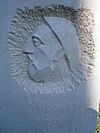 |
Borna | c. 810 | 821 | Son of Višeslav. Vassal of Frankish Emperor Charlemagne. His titles were Duke of the Guduscani, Duke of Dalmatia and Liburnia. Since Croats inhabited those areas at the time, he is considered a Croatian duke. |
| Vladislav | 821 | c. 823 | Nephew of Borna | |
| Ljudemisl | c. 823 | c. 835 | Some sources claim he may have killed Ljudevit, the Pannonian duke. | |
| Mislav | c. 835 | c. 845 | ||
| House of Trpimirović | ||||
 |
Trpimir | c. 845 | 864 | Founder of the Trpimirović dynasty |
| Zdeslav | 864 | 864 | Son of Trpimir | |
| House of Domagojević | ||||
 |
Domagoj | 864 | 876 | Overthrew Zdeslav. |
| Unnamed son of Domagoj | 876 | 878 | Later killed during a civil war. | |
| House of Trpimirović | ||||
| Zdeslav | 878 | 879 | Restored ruler, overthrew the unnamed son of Domagoj. Killed by Branimir in May 879. | |
| House of Domagojević | ||||
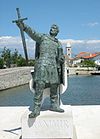 |
Branimir | 879 | c. 892 | |
| House of Trpimirović | ||||
| Muncimir | 892 | 910 | Son of Trpimir. Also called Mutimir. | |
| Tomislav I | 910 | 925 | ||
Kings of Croatia (925–1102)[]
In his letter from 925, Pope John X refers to Tomislav I as Rex Chroatorum (King of the Croats). All Croatian rulers after Tomislav held the title of king.
| Portrait | Name | Reign start | Reign end | Notes |
|---|---|---|---|---|
| House of Trpimirović | ||||
| Tomislav I | 925 | 928 | Possibly the son of Muncimir. After his death, civil wars weakened the state and some territory, including Bosnia, was lost. His title as rex (king) is based on two contemporary documents:
He was also addressed as princeps (prince) and dux (duke) on other occasions. Nevertheless, in modern Croatia he is traditionally considered the first (and arguably the most famous) Croatian king. | |
| Trpimir II | 928 | 935 | Younger brother or son of Tomislav | |
 |
Krešimir I | 935 | 945 | Son of Trpimir II |
 |
Miroslav | 945 | 949 | Son of Krešimir I |
 |
Michael Krešimir II | 949 | 969 | Younger brother of Miroslav. Michael Krešimir ruled jointly with his wife Queen Helen of Zadar. During their reign, the Croatian Kingdom regained previously lost territories, including Bosnia. Upon Michael Krešimir's death in 969, his wife ruled as regent for their underage son Stephen Držislav. |
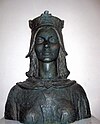 |
Helen of Zadar | 969 | 976 | Ruled as regent for her son Stephen Držislav from 969 until her death 8 October 976. |
| Stephen Držislav | 969 | 997 | Son of Michael Krešimir and Queen Helen of Zadar. He received royal insigia as an act of recognition from the Byzantine Emperor and was crowned by the Archbishop of Split in Biograd in 988. Thomas the Archdeacon's Historia Salonitana names him as the first King of Croatia (rex), regardless, he is considered the first crowned Croatian king.[1] | |
 |
Svetoslav Suronja | 997 | 1000 | Son of Stephen Držislav. Dethroned by his brothers Krešimir III and Gojslav. |
 |
Gojslav | 1000 | 1020 | Younger brother of Svetoslav Suronja. Co-ruled with Krešimir III. |
 |
Krešimir III | 1000 | 1030 | Younger brother of Svetoslav Suronja. Ruled alone after the death of Gojslav in 1020 |
 |
Stephen I | 1030 | 1058 | Son of Krešimir III |
 |
Peter Krešimir IV the Great | 1058 | 1074 | Son of Stephen I. During his reign the Croatian Kingdom reached its peak |

|
Demetrius Zvonimir | 1075 | 1089 | Cousin of Peter Krešimir IV. Married Princess Helen, daughter of King Béla I of Hungary (c. 1063). |
 |
Stephen II | 1089 | 1090/91 | Son of Častimir who was younger brother of King Peter Krešimir IV the Great. |
| House of Árpád | ||||
 |
Ladislaus I | 1091 | 1095 | After the death of King Demetrius Zvonimir in 1089, King Ladislaus I of Hungary (1077–1095) ruled in Slavonia. After the death of Stephen II, he conquered Croatia and adopted the title King of Croatia in 1091. He set his nephew Álmos to rule as his proxy with the title of duke (1091–1095), but he was recognized only by the Hungarian nobility. Álmos was defeated by the newly elected Croatian king Petar Svačić who expelled him from Slavonia in 1095, which was again annexed to the Croatian Kingdom. |
| House of Svačić | ||||
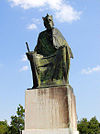 |
Petar Svačić | 1093 | 1097 | Petar Svačić was elected to rule by the Croatian nobles. He fought with Coloman of Hungary for control of Croatia and was killed at the Battle of Gvozd Mountain in 1097. From 1102 onwards, the Kings of Hungary were also Kings of Croatia, because of the political union of the two crowns. |
Hungarian kings of Croatia (1102–1527)[]
From 1102, the reigning King of Hungary is also the ruler of the Kingdom of Croatia in agreement with the Croatian nobles.[2][3] Croatia is governed on his behalf by a viceroy (ban) and a parliament (sabor).
| Portrait | Name | Reign start | Reign end | Notes |
|---|---|---|---|---|
| House of Árpád | ||||
 |
Coloman | 1102 | 3 February 1116 | King of Hungary from 1095 and King of Croatia from 1102 until his death in 1116. Coloman, supported by Pannonian Croats, defeated an army of Croatian and Dalmatian nobles allied to Petar Svačić at the Battle of Gvozd Mountain. Recognized by a council (sabor) of Croatian nobles and crowned as King of Croatia in 1102. |
 |
Stephen II | 3 February 1116 | 3 April 1131 | Son of Coloman |
| Béla II the Blind | 3 April 1131 | 13 February 1141 | Grandson of Géza I, son of Álmos. He was Coloman's younger brother. | |
 |
Géza II | 13 February 1141 | 31 May 1162 | Son of Béla II the Blind |
 |
Stephen III | 31 May 1162 | 4 March 1172 | Son of Géza II |
| Ladislaus II | 31 May 1162 | 14 January 1163 | Rebel anti-king, younger brother of Géza II | |
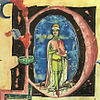 |
Stephen IV | 14 January 1163 | June 1163 | Rebel anti-king, younger brother of Géza II |
 |
Béla III | 4 March 1172 | 13 April 1196 | Younger brother of Stephen III |
 |
Emeric | 13 April 1196 | 30 November 1204 | Son of Béla III |
 |
Ladislaus III | 30 November 1204 | 7 May 1205 | Son of Emeric, crowned and died as a child |
 |
Andrew II | 7 May 1205 | 21 September 1235 | Brother of Emeric. In 1222, he issued a Golden Bull which established the rights of noblemen, including the right to disobey the king when he acted contrary to law. |
 |
Béla IV | 21 September 1235 | 3 May 1270 | Son of Andrew II. Ruled during First Mongol invasion (1241–1242). In 1242, he issued a Golden Bull which proclaimed Zagreb and Samobor a free royal city. |
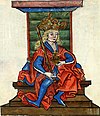 |
Stephen V | 3 May 1270 | 6 August 1272 | Son of Béla IV. Prince of Slavonia from 1246 to 1257 |
| Ladislaus IV the Cuman | 6 August 1272 | 10 July 1290 | Son of Stephen V. He lived with the nomad Cuman tribes contrary to the wishes of the Catholic clergy and was thus excommunicated. | |
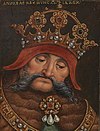 |
Andrew III the Venetian | 4 August 1290 | 14 January 1301 | Grandson of Andrew II. Last Hungarian king from the Árpád dynasty. |
| House of Přemyslid | ||||
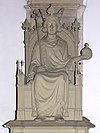 |
Wenceslaus | 27 August 1301 | 9 October 1305 | Great-great-grandson of Béla IV. Rule contested by Charles Robert of Anjou (Charles I of Hungary). |
| House of Wittelsbach | ||||
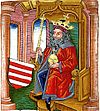 |
Béla V | 9 October 1305 | May 1307 | Grandson of Béla IV. Rule contested by Charles Robert of Anjou (Charles I of Hungary). |
| House of Anjou | ||||
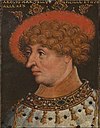 |
Charles Martel of Anjou | 1290 | 1295 | Set up by Pope Nicholas IV and the ecclesiastical party as successor of his maternal uncle, the childless Ladislaus IV the Cuman. His title as king was recognized by the Šubić and Kőszegi noble families. He was crowned in Croatia. |
| Charles I | 14 January 1301 | 16 July 1342 | Son of Charles Martel of Anjou. Also called Charles Robert. Rule contested by Wenceslaus of Přemyslid and Béla V of Wittesbach. | |
 |
Louis I the Great | 16 July 1342 | 11 September 1382 | Also King of Poland from 1370 to 1382 |
 |
Mary | 11 September 1382 | 17 May 1395 | Married Sigismund of Luxembourg after he invaded Upper Hungary in 1385. After the assassination of King Charles II in 1386, Mary officially remained the co-ruler with her husband Sigismund. |
 |
Charles II | 31 December 1385 | 24 February 1386 | Also King of Naples. After Mary renounced the throne, Charles III of Naples was crowned as King Charles II of Hungary on 31 December 1385. He was wounded in an assassination attempt at the instigation of Mary's mother on 7 February 1386 and died on 24 February that same year. |
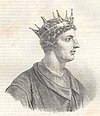 |
Ladislaus of Naples | 1390 | 1414 | Son of Charles II. He claimed the Crown of Hungary and Croatia since 1390 in opposition to Mary and Sigismund of Luxemburg. Never crowned. |
| House of Luxembourg | ||||
 |
Sigismund | 31 March 1387 | 9 December 1437 | Also King of Bohemia from 1419 and Holy Roman Emperor from 1433 until his death in 1437. |
| House of Habsburg | ||||
 |
Albert I | 18 December 1437 | 27 October 1439 | Son-in-law of Sigismund. He was also King of Bohemia from 1438 until his death in 1439. |
| House of Jagiellon | ||||
 |
Vladislaus I | 15 May 1440 | 10 November 1444 | Also King of Poland from 1434 until his death in 1444. Crown contested by Ladislaus V the Posthumus. |
| House of Habsburg | ||||
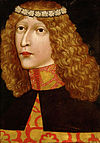
|
Ladislaus V the Posthumus | 10 November 1444 | 23 November 1457 | Son of Albert I. Born in 1440 after his father's death, spent most of his life in captivity. Crown contested by Vladislaus I between 1440 and 1444. He had no children and was the last of the Albertinian line of the Habsburg dynasty. |
| House of Hunyadi | ||||
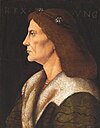 |
Matthias I | 24 January 1458 | 6 April 1490 | Elected by the nobles. He was son of John Hunyadi. Also King of Bohemia from 1469 until his death in 1490, a title he contested with Vladislaus II. |
| House of Jagiellon | ||||
 |
Vladislaus II | 15 July 1490 | 13 May 1516 | Also King of Bohemia from 1471 (contested with Matthias I until 1490). The Hungarian nobles elected him king after his supporters defeated the son of Matthias I who relinquished his claim to the Hungarian throne prior to that. Died in 1516. |
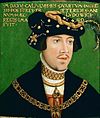 |
Louis II | 13 May 1516 | 29 August 1526 | Also King of Bohemia from 1516 until his death in 1526 at the Battle of Mohács. |
| House of Zápolya | ||||
 |
John I | 10 November 1526 | 22 July 1540 | Claimed the throne with the support of Hungarian nobles and later Suleiman the Magnificent. Kingship contested between Ferdinand I of Habsburg. John I made an agreement with Ferdinand I to recognize his right to reunite Hungary after John I's death, but shortly after John his son's birth, and on his deathbed, John I bequeathed his realm to his son. |
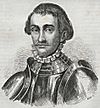
|
John II | 13 September 1540 | 16 August 1570 | Son of John I. Elected by supporters of John I as King of Hungary. Claim contested by Ferdinand I and Maximilian. Never crowned. |
Under the Habsburgs (1527–1918)[]
On 1 January 1527, the Croatian Parliament met in Cetin to elect Ferdinand I of Habsburg as the new King of Croatia.
| Portrait | Name | Reign start | Reign end | Notes |
|---|---|---|---|---|
| House of Habsburg | ||||
 |
Ferdinand I | 16 December 1526 | 25 July 1564 | Claimed the throne according to the agreement between the House of Jagiellon and the House of Habsburg |
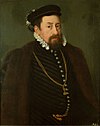 |
Maximilian | 8 September 1563 | 12 October 1576 | Ruled during Battle of Szigetvár and Croatian-Slovene Peasant Revolt. |
 |
Rudolf | 25 September 1572 | 26 June 1608 | Ruled during Battle of Sisak. Abdicated in favor of his younger brother Matthias II. |
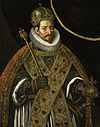 |
Matthias II | 26 June 1608 | 20 March 1619 | Brother of Rudolf |
 |
Ferdinand II | 1 July 1618 | 15 February 1637 | In 1630, he issued Statuta Valachorum that placed Vlachs (mainly Orthodox Serbs) in the Military Frontier under the direct rule by Vienna, removing the Croatian Parliament's jurisdiction over them. |
 |
Ferdinand III | 8 December 1625 | 2 April 1657 | |
 |
Ferdinand IV | 16 June 1647 | 9 July 1654 | |
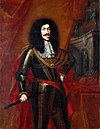 |
Leopold I | 27 June 1657 | 5 May 1705 | Crushed the Zrinski–Frankopan Conspiracy and abolished the right of the Croatian Parliament to elect a king. In 1669, he founded the University of Zagreb |
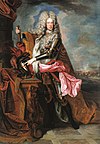 |
Joseph I | 5 May 1705 | 17 April 1711 | |
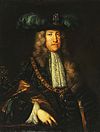 |
Charles III | 11 April 1711 | 20 October 1740 | Issued and edict called the Pragmatic Sanction where he acknowledged female inheritance of the Austrian crown after extinction of the male line and thus enabling his daughter Maria Theresa to become sovereign. |
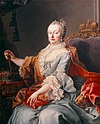 |
Maria Theresa | 20 October 1740 | 29 November 1780 | Divided Croatia into counties (županije). In 1767, she formed a Croatian Royal Council (Consilium Regium) until 1779 when she abolished it. She conducted military and economy reforms, especially concerning serfdom and schooling. |
| House of Habsburg-Lorraine | ||||
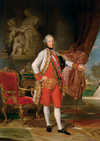 |
Joseph II | 29 November 1780 | 20 February 1790 | Abolished serfdom and conducted a partial Germanization of Croatian lands. |
 |
Leopold II | 20 February 1790 | 1 March 1792 | |
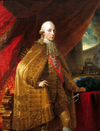 |
Francis I | 1 March 1792 | 2 March 1835 | |
 |
Ferdinand V | 28 September 1830 | 2 December 1848 | Being epileptic and mentally ill, abdicated in favour of his nephew Franz Joseph (son of his younger brother Franz Karl). Ferdinand V died in 1875. |
 |
Franz Joseph I | 2 December 1848 | 21 November 1916 | Longest ruling Croatian monarch. During his reign, Croatian lands (Croatia, Slavonia and Dalmatia) were unified by Ban Josip Jelačič in 1848. In 1867, he reorganized the monarchy into a dual Austrian and Hungarian part. From 1868, the Kingdom of Croatia-Slavonia was an autonomous kingdom within the Kingdom of Hungary. |
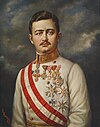 |
Charles IV | 21 November 1916 | 16 November 1918 | In his coronation oath to the Croatian Parliament, he acknowledged the unity of Croatia, Dalmatia and Slavonia with Rijeka.[4] During the last days of the monarchy he accepted the trialist manifest on creating a so-called "Zvonimir's Kingdom".[5][6][7][8][9] He reigned until 1918, when he renounced participation in state affairs, but did not abdicate. The Croatian Parliament ended the union of Croatia with Hungary and Austria on 29 October 1918 but never dethroned King Charles IV.[10] He spent the remaining years of his life attempting to restore the monarchy until his death in 1922. |
Kings of Yugoslavia (1918–1941)[]
After the World War I and the breakup of Austria-Hungary, Croatia joined a newly formed State of Slovenes, Croats and Serbs. Following a brief period of self-rule, that state became part of the Kingdom of Serbs, Croats and Slovenes under the Karađorđević dynasty. The name of the kingdom was changed in 1929, amid unitarianist reforms, to the Kingdom of Yugoslavia. In 1941, Yugoslavia was occupied by the Axis powers along with the rest of Yugoslavia. The Axis set up the Independent State of Croatia as a puppet state, while many Croats fought for the Yugoslav Partisans.
| Portrait | Name | Reign start | Reign end | Notes |
|---|---|---|---|---|
| House of Karađorđević | ||||
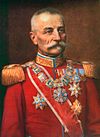 |
Peter I | 1 December 1918 | 16 August 1921 | |
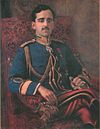 |
Alexander I | 16 August 1921 | 9 October 1934 | Assassinated by the VMRO with Ustaše support in 1934. |
 |
Peter II | 9 October 1934 | 29 November 1941 | Prince Paul of Yugoslavia was his regent. Exiled to Great Britain after Axis invasion in 1941. |
King of the Independent State of Croatia (1941–1943)[]
During the Axis occupation of Yugoslavia, a puppet state under Italian protection called the Independent State of Croatia was created, with Ante Pavelić as its leader. Soon after its creation, the state government passed three laws on the creation of the Crown of Zvonimir, which made the country de jure a kingdom.[11][12] Three days later the Treaties of Rome were signed. The Italian Prince Aimone of Savoy-Aosta was designated King of Croatia. He abdicated in 1943.
| Portrait | Name | Reign start | Reign end | Notes |
|---|---|---|---|---|
| House of Savoy-Aosta | ||||
 |
Tomislav II | 18 May 1941 | 31 July 1943 | Tomislav II established a Croatian royal office (kraljevski stol) in Florence and later in Rome.[13][14] He had at first refused to assume the kingship in opposition to the Italian annexation of the Dalmatia region,[15] and is therefore referred to in some sources as king designate.[16][17][18][19] He abdicated on 31 July 1943 after the dismissal of Benito Mussolini on the orders of Victor Emmanuel III.[20][21][22][23] |
After WWII[]
- List of heads of state of Yugoslavia (1945–1991)
- List of presidents of Croatia (1991–present)
- List of prime ministers of Croatia (1991–present)
Gallery[]
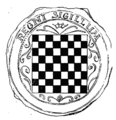
The seal of the Kingdom of Croatia and Dalmatia was affixed in 1527 to the Cetin Charter that confirmed the Habsburg to be the rulers of Croatia

Coat of arms of the Lands of the Crown of Saint Stephen under the House of Habsburg (note the symbols of Croatia, Dalmatia and Slavonia). The Habsburgs ruled the Kingdom of Croatia for just under 470 years, longer than any other dynasty.

Coat of arms of the Kingdom of Yugoslavia. Note the Croatian chequy which forms a part of the coat of arms along with the Slovenian and Serbian symbols.
"Duke of Croatia"[]
The title Duke of Croatia has been used widely:
- The Doges of Venice used it, with Byzantine approval, from c. 1100, when Hungary was in the process of absorbing the Kingdom of Croatia, until the Treaty of Zadar with Hungary in 1358.
- The Dukes of Merania, whose territory bordered Croatia, were sometimes called Dukes of Croatia in contemporary chronicles.
- Various Hungarian noblemen granted authority in the South Slav lands added Croatia to their title of Duke of Slavonia in the 13th and 14th centuries.
See also[]
- Ban of Croatia
- Ban of Slavonia
- List of rulers of Austria
- Croatian Parliament
- History of Croatia
- Timeline of Croatian history
References[]
- ^ Thomas the Archdeacon: Historia Salonitana, caput 13.
- ^ Catholic Encyclopedia
- ^ http://fmg.ac/Projects/MedLands/CROATIA.htm#UlricCillydied1456
- ^ (Hrvatska) Krunidbena zavjernica Karla IV. hrvatskom Saboru 28. prosinca 1916. (sa grbom Dalmacije, Hrvatske, Slavonije i Rijeke iznad teksta), str. 1.-4. Hrvatski Državni Arhiv./ENG. (Croatian) Coronation oath of Karl IV to Croatian Sabor (parliament), 28th December 1916. (with coat of arms of Dalmatia, Croatia, Slavonia and Rijeka above the text), p.1-4 Croatian State Archives
- ^ A. Pavelić (lawyer) Doživljaji, p.432.
- ^ Dr. Aleksandar Horvat Povodom njegove pedesetgodišnjice rodjenja, Hrvatsko pravo, Zagreb, 17/1925., no. 5031
- ^ Edmund von Glaise-Horstenau,Die Katastrophe. Die Zertrümmerung Österreich-Ungarns und das Werden der Nachfolgestaaten, Zürich – Leipzig – Wien 1929, p.302-303.
- ^ Same page 132.-133.
- ^ F. Milobar Slava dr. Aleksandru Horvatu!, Hrvatsko pravo, 20/1928., no. 5160
- ^ Hrvatska Država, newspaper Public proclamation of the Sabor 29.10.1918. Issued 29.10.1918. no. 299. p.1.
- ^ Hrvatski Narod (newspaper)16.05.1941. no. 93. p.1.,Public proclamation of theZakonska odredba o kruni Zvonimirovoj (Decrees on the crown of Zvonimir), tri članka donesena 15.05.1941.
- ^ Die Krone Zvonimirs, Monatshefte fur Auswartige Politik, Heft 6(1941)p.434.
- ^ Hrvoje Matković, Designirani hrvatski kralj Tomislav II. vojvoda od Spoleta. Povijest hrvatskotalijanskih odnosa u prvoj polovici XX.st. (Designated Croatian king Tomislav II. Duke of Spoleto. History of Croatian-Italian relationships in first half of the 20th century), Zagreb 2007.
- ^ Avramov, Smilja (1995). Genocide in Yugoslavia. p. 238.
- ^ Rodogno, Davide; Fascism's European empire: Italian occupation during the Second World War; p.95; Cambridge University Press, 2006 ISBN 0-521-84515-7
"Devoid of political experience and ignorant of the Italian government's exact intentions, he [the Duke Aimone] refused to leave for Croatia, saying so in letters to Victor Emmanuel and Mussolini, in which he told them that the question of Dalmatia, 'a land that could never be Italianized', was an obstacle against any reconciliation with the Croats. Never, he declared, would he agree to be a king of a nation amputated from Italy." [1]. - ^ Pavlowitch, Stevan K.; Hitler's new disorder: the Second World War in Yugoslavia; p.289; Columbia University Press, 2008 0-231-70050-4 [2]
- ^ Massock, Richard G.; Italy from Within; p.306; READ BOOKS, 2007 ISBN 1-4067-2097-6 [3]
- ^ Burgwyn, H. James; Empire on the Adriatic: Mussolini's conquest of Yugoslavia 1941-1943; p.39; Enigma, 2005 ISBN 1-929631-35-9
- ^ Royal Institute of International Affairs; Enemy Countries, Axis-Controlled Europe; Kraus International Publications, 1945 ISBN 3-601-00016-4 [4]
- ^ "Duke gives up puppet throne". St. Petersburg Times. 21 August 1943. p. 10.
- ^ Lemkin, Raphael; Power, Samantha (2005). Axis Rule in Occupied Europe: Laws of Occupation, Analysis of Government, Proposals For Redress. Lawbook Exchange. p. 253. ISBN 1584775769.
- ^ "Foreign News: Hotel Balkania". Time Magazine. 9 August 1943. Archived from the original on 8 March 2008. Retrieved 4 December 2009.
- ^ B. Krizman, NDH između Hitlera i Mussolinija (Independent State of Croatia between Hitler and Mussolini,)p.102
External links[]
- Monarchs of Croatia from Everything2
- The History Files: Kingdoms of Eastern Europe: Croatia
- WHKMLA History of Croatia, ToC
- Rulers of Croatia and Slavonia
- List of Croatian rulers[permanent dead link] PDF, University of Michigan
- [5]
- List of Croatian Heads of State
- Kingdom of Croatia
- Bans of Croatia
- Lists of European rulers
- Lists of political office-holders in Croatia
- Croatia history-related lists


